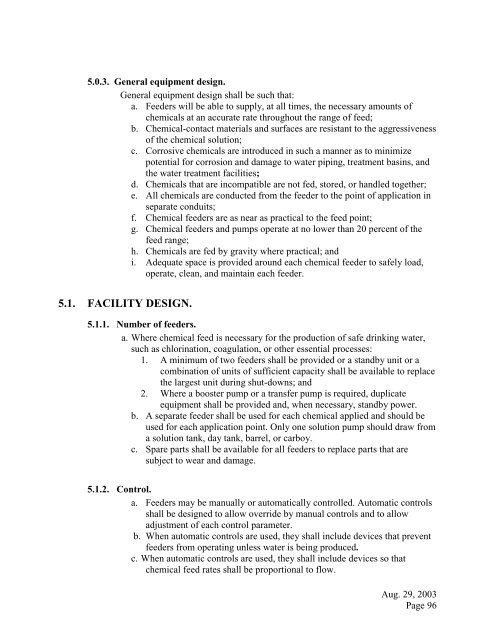Design Guide for Community Water Systems - The Water, Sanitation ...
Design Guide for Community Water Systems - The Water, Sanitation ...
Design Guide for Community Water Systems - The Water, Sanitation ...
You also want an ePaper? Increase the reach of your titles
YUMPU automatically turns print PDFs into web optimized ePapers that Google loves.
5.0.3. General equipment design.General equipment design shall be such that:a. Feeders will be able to supply, at all times, the necessary amounts ofchemicals at an accurate rate throughout the range of feed;b. Chemical-contact materials and surfaces are resistant to the aggressivenessof the chemical solution;c. Corrosive chemicals are introduced in such a manner as to minimizepotential <strong>for</strong> corrosion and damage to water piping, treatment basins, andthe water treatment facilities;d. Chemicals that are incompatible are not fed, stored, or handled together;e. All chemicals are conducted from the feeder to the point of application inseparate conduits;f. Chemical feeders are as near as practical to the feed point;g. Chemical feeders and pumps operate at no lower than 20 percent of thefeed range;h. Chemicals are fed by gravity where practical; andi. Adequate space is provided around each chemical feeder to safely load,operate, clean, and maintain each feeder.5.1. FACILITY DESIGN.5.1.1. Number of feeders.a. Where chemical feed is necessary <strong>for</strong> the production of safe drinking water,such as chlorination, coagulation, or other essential processes:1. A minimum of two feeders shall be provided or a standby unit or acombination of units of sufficient capacity shall be available to replacethe largest unit during shut-downs; and2. Where a booster pump or a transfer pump is required, duplicateequipment shall be provided and, when necessary, standby power.b. A separate feeder shall be used <strong>for</strong> each chemical applied and should beused <strong>for</strong> each application point. Only one solution pump should draw froma solution tank, day tank, barrel, or carboy.c. Spare parts shall be available <strong>for</strong> all feeders to replace parts that aresubject to wear and damage.5.1.2. Control.a. Feeders may be manually or automatically controlled. Automatic controlsshall be designed to allow override by manual controls and to allowadjustment of each control parameter.b. When automatic controls are used, they shall include devices that preventfeeders from operating unless water is being produced.c. When automatic controls are used, they shall include devices so thatchemical feed rates shall be proportional to flow.Aug. 29, 2003Page 96
















